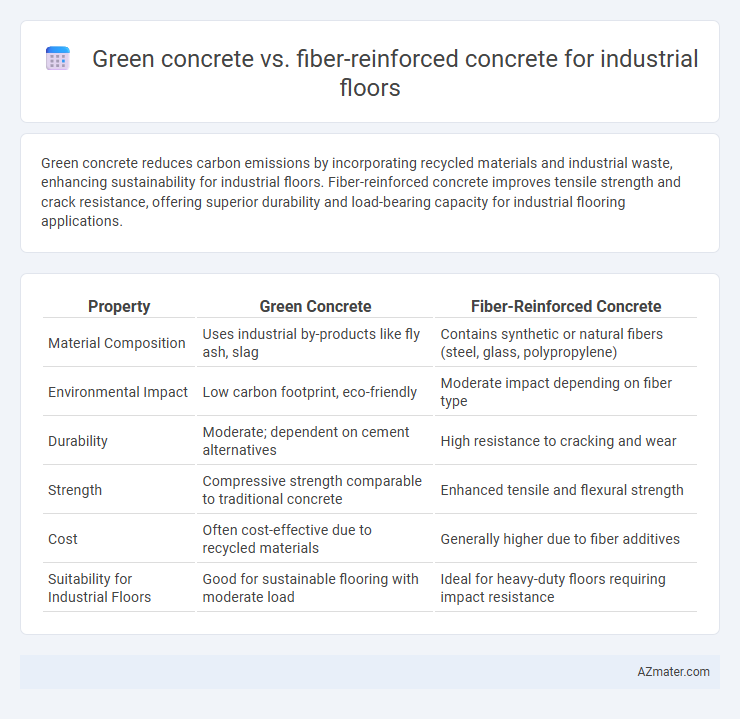Green concrete reduces carbon emissions by incorporating recycled materials and industrial waste, enhancing sustainability for industrial floors. Fiber-reinforced concrete improves tensile strength and crack resistance, offering superior durability and load-bearing capacity for industrial flooring applications.
Table of Comparison
| Property | Green Concrete | Fiber-Reinforced Concrete |
|---|---|---|
| Material Composition | Uses industrial by-products like fly ash, slag | Contains synthetic or natural fibers (steel, glass, polypropylene) |
| Environmental Impact | Low carbon footprint, eco-friendly | Moderate impact depending on fiber type |
| Durability | Moderate; dependent on cement alternatives | High resistance to cracking and wear |
| Strength | Compressive strength comparable to traditional concrete | Enhanced tensile and flexural strength |
| Cost | Often cost-effective due to recycled materials | Generally higher due to fiber additives |
| Suitability for Industrial Floors | Good for sustainable flooring with moderate load | Ideal for heavy-duty floors requiring impact resistance |
Introduction to Industrial Concrete Solutions
Green concrete offers sustainability benefits through reduced carbon emissions and the use of recycled materials, making it an eco-friendly choice for industrial floors. Fiber-reinforced concrete enhances tensile strength and crack resistance, improving durability and load-bearing capacity under heavy machinery. Selecting between these solutions depends on prioritizing environmental impact or structural performance in industrial flooring applications.
Overview of Green Concrete
Green concrete, made using recycled materials and industrial by-products like fly ash and slag, offers enhanced sustainability by reducing carbon emissions and conserving natural resources in industrial flooring applications. Its lower environmental impact combined with adequate strength and durability makes it an eco-friendly alternative to traditional concrete. Green concrete also supports LEED certification goals, making it a preferred choice for industrial floors seeking sustainability without compromising performance.
Overview of Fiber-Reinforced Concrete
Fiber-reinforced concrete (FRC) enhances industrial floor performance by incorporating synthetic or steel fibers, significantly improving tensile strength, crack resistance, and durability compared to traditional concrete. This composite material reduces shrinkage and impacts from heavy machinery, making it ideal for environments demanding high load capacity and abrasion resistance. Unlike green concrete, which emphasizes sustainability through recycled materials and low carbon footprint, fiber-reinforced concrete prioritizes structural integrity and longevity in industrial flooring applications.
Key Material Composition Differences
Green concrete primarily incorporates recycled materials such as fly ash, slag cement, and silica fume to reduce its environmental footprint, while maintaining traditional cement content for strength. Fiber-reinforced concrete includes synthetic or steel fibers distributed throughout the mix to improve tensile strength, crack resistance, and durability under heavy industrial loads. The key difference lies in green concrete's emphasis on sustainable, eco-friendly materials versus fiber-reinforced concrete's focus on enhanced mechanical performance through fiber integration.
Sustainability and Environmental Impact
Green concrete incorporates recycled materials and industrial by-products, significantly reducing carbon emissions and raw material consumption, making it a sustainable choice for industrial floors. Fiber-reinforced concrete enhances structural durability and crack resistance, extending the lifespan of floors and minimizing maintenance-related environmental impacts. Both materials contribute to eco-friendly construction, with green concrete excelling in resource conservation and fiber-reinforced concrete improving long-term environmental performance through enhanced durability.
Mechanical Strength and Durability
Green concrete, incorporating industrial by-products like fly ash and slag, offers enhanced durability and reduced environmental impact but generally exhibits moderate mechanical strength suitable for lighter industrial floor loads. Fiber-reinforced concrete (FRC), embedded with synthetic or steel fibers, significantly improves tensile strength, crack resistance, and impact durability, making it ideal for heavy-duty industrial floors subject to dynamic stresses. For industrial flooring requiring superior load-bearing capacity and long-term resilience, fiber-reinforced concrete outperforms green concrete in mechanical strength and durability metrics.
Crack Resistance and Flexural Behavior
Green concrete demonstrates improved crack resistance due to the inclusion of supplementary cementitious materials like fly ash and slag, enhancing durability and minimizing shrinkage-induced cracks in industrial floors. Fiber-reinforced concrete significantly improves flexural behavior by distributing tensile stresses via embedded fibers such as steel or polypropylene, which effectively control crack propagation and increase load-bearing capacity. Both materials contribute to crack resistance, but fiber-reinforced concrete offers superior flexural performance critical for industrial flooring subjected to heavy dynamic loads.
Installation Process and Practical Considerations
Green concrete for industrial floors involves mixing recycled materials and supplementary cementitious components, requiring careful moisture control during installation to ensure proper curing and strength. Fiber-reinforced concrete incorporates synthetic or steel fibers directly into the mix, enhancing tensile strength and crack resistance, with a straightforward placement process similar to conventional concrete but demanding consistent fiber dispersion for optimal performance. Practical considerations include the environmental benefits and potential cost savings of green concrete versus the durability and reduced maintenance needs offered by fiber-reinforced concrete in high-traffic industrial settings.
Cost Efficiency and Lifecycle Value
Green concrete offers cost efficiency through reduced material expenses and lower environmental impact, utilizing recycled industrial byproducts like fly ash or slag, which can decrease raw material costs by up to 30%. Fiber-reinforced concrete enhances lifecycle value by improving durability and resistance to cracking under heavy industrial loads, reducing maintenance and repair costs over time by approximately 20-25%. For industrial floors, green concrete provides an eco-friendly, budget-friendly initial investment, while fiber-reinforced concrete extends service life and minimizes long-term operational expenses.
Choosing the Optimal Concrete for Industrial Floors
Green concrete, made with recycled materials and reduced cement content, offers enhanced sustainability and lower carbon footprint for industrial floors, ensuring durability and environmental compliance. Fiber-reinforced concrete incorporates synthetic or steel fibers to significantly improve tensile strength, crack resistance, and impact durability, making it ideal for heavy-load industrial applications. Choosing the optimal concrete depends on specific requirements such as load intensity, environmental impact goals, and long-term maintenance, with fiber-reinforced concrete excelling in structural performance while green concrete prioritizes eco-friendly attributes.

Infographic: Green concrete vs Fiber-reinforced concrete for Industrial floor
 azmater.com
azmater.com